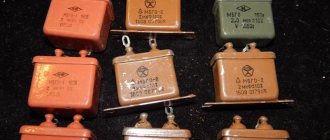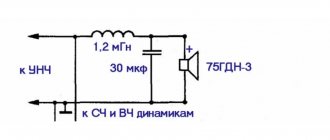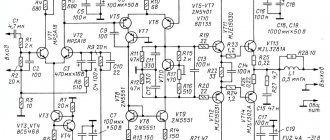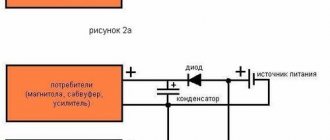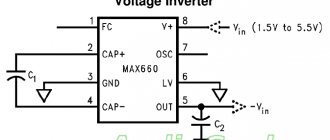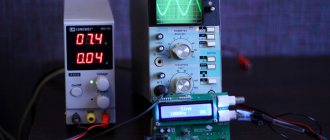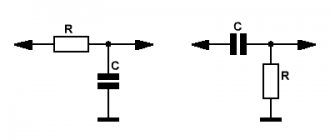Basic information about the characteristics of capacitors, which are components of almost all electronic circuits, is usually placed on their cases. Depending on the standard size of the element, manufacturer, production time, the data applied to the electronic device constantly changes not only in composition, but also in appearance.
With a decrease in the size of the case, the composition of alphanumeric designations was changed, encoded, and replaced by color markings. The variety of internal standards used by manufacturers of radio-electronic elements requires certain knowledge to correctly interpret the information printed on an electronic device.
What is a capacitor?
A device that stores electricity in the form of electrical charges is called a capacitor.
The amount of electricity or electric charge in physics is measured in coulombs (C). Electrical capacitance is calculated in farads (F).
A solitary conductor with an electrical capacity of 1 farad is a metal ball with a radius equal to 13 radii of the Sun. Therefore, a capacitor includes at least 2 conductors, which are separated by a dielectric. In simple device designs, paper is used.
The operation of a capacitor in a DC circuit is carried out when the power is turned on and off. Only during transient moments does the potential on the plates change.
The capacitor in the AC circuit recharges at a frequency equal to the frequency of the power source voltage. As a result of continuous charges and discharges, current flows through the element. A higher frequency means the device recharges faster.
The resistance of the circuit with a capacitor depends on the frequency of the current. At zero frequency of direct current, the resistance value tends to infinity. As the AC frequency increases, the resistance decreases.
Application
Capacitors are used in almost all areas of electrical engineering. Let's list just a few of them:
- construction of feedback circuits, filters, oscillatory circuits;
- use as a memory element;
- for reactive power compensation;
- to implement logic in some types of protection;
- as a sensor for measuring liquid level;
- for starting electric motors in single-phase AC networks.
Using this radio-electronic element, it is possible to receive high-power pulses, which is used, for example, in photo flashes and in the ignition systems of carburetor engines.
Operating principle of capacitors
When a circuit is connected to an electrical source, electrical current begins to flow through the capacitor. At the beginning of the passage of current through the capacitor, its strength is at its maximum and the voltage is at its minimum. As the device accumulates charge, the current drops until it disappears completely, and the voltage increases.
During the process of charge accumulation, electrons accumulate on one plate and positive ions on the other. Charge does not flow between the plates due to the presence of a dielectric. This is how the device accumulates charge. This phenomenon is called the accumulation of electric charges, and the capacitor is called an electric field accumulator.
Storage Features
Tantalum capacitors are able to maintain performance characteristics for a long time. If the required conditions are observed (temperature up to +40°, relative humidity 60%), the capacitor loses its ability to be soldered during long-term storage, while maintaining other performance characteristics.
General recommendations for extending the service life of a tantalum capacitor and increasing the safety of its operation:
- Compliance with technical process requirements;
- Multi-stage product quality control;
- Compliance with storage conditions;
- Fulfilling the requirements for organizing a workplace for mounting devices on a board;
- Compliance with the recommended soldering temperature conditions;
- Correct selection of safe operating modes;
- Compliance with operating requirements.
Characteristics and properties
Capacitor parameters that are used to create and repair electronic devices include:
- Capacity - C. Determines the amount of charge that the device holds. The value of the nominal capacity is indicated on the case. To create the required values, the elements are included in the circuit in parallel or in series. Operational values do not coincide with calculated values.
- Resonant frequency - fр. If the current frequency is greater than the resonant one, then the inductive properties of the element appear. This makes work difficult. To ensure the design power in the circuit, it is reasonable to use a capacitor at frequencies below resonant values.
- Rated voltage - Un. To prevent breakdown of the element, the operating voltage is set less than the rated voltage. The parameter is indicated on the capacitor body.
- Polarity. If the connection is incorrect, breakdown and failure will occur.
- Electrical insulation resistance - Rd. Determines the leakage current of the device. In devices, parts are located close to each other. At high leakage current, parasitic connections in the circuits are possible. This leads to malfunctions. Leakage current worsens the capacitive properties of the element.
- Temperature coefficient - TKE. The value determines how the capacitance of the device changes with fluctuations in ambient temperature. The parameter is used when developing devices for operation in harsh climatic conditions.
- Parasitic piezoelectric effect. Some types of capacitors create noise in devices when deformed.
Physical quantities used in marking the capacitance of ceramic capacitors
To determine the value of capacitance in the international system of units (SI), the Farad (F, F) is used. This is too large a value for a standard electrical circuit, so smaller units are used in marking household capacitors.
Table of capacitance units used for household ceramic capacitors
| Unit name | Designation options | Power relative to Farad | |
| Microfarad | Microfarad | µF, µF, uF, mF | 10-6F |
| Nanofarad | Nanofarad | nF, nF | 10-9F |
| Picofarad | Picofarad | pF, pF, mmF, uuF | 10-12F |
The off-label unit millifarad is rarely used - 1 mF (10-3F).
Marking of domestic capacitors
All post-Soviet enterprises are characterized by fairly complete labeling of radioelements, allowing for minor differences in designations.
Capacity
The first and most important parameter of a capacitor is capacitance. In this regard, the value of this characteristic is placed in first place and is encoded with an alphanumeric designation. Since the unit of measurement of capacitance is the farad, the letter designation contains either the symbol of the Cyrillic alphabet “F” or the symbol of the Latin alphabet “F”.
Since the farad is a large value, and the elements used in industry have much smaller values, the units of measurement have a variety of diminutive prefixes (mili-, micro-, nano- and pico). Letters of the Greek alphabet are also used to designate them.
- 1 millifarad is equal to 10-3 farads and is denoted 1mF or 1mF.
- 1 microfarad is equal to 10-6 farads and is designated 1 µF or 1F.
- 1 nanofarad is equal to 10-9 farads and is denoted 1nF or 1nF.
- 1 picofarad is equal to 10-12 farads and is denoted 1pF or 1pF.
Marking of imported capacitors
To date, the standards that have been adopted from the IEC apply not only to foreign types of equipment, but also to domestic ones. This system involves applying a code type marking to the product body, which consists of three direct numbers.
The two numbers that are located from the very beginning indicate the capacity of the item and in units such as picofarads. The number that is located third in order is the number of zeros. Let's look at this using the example of 555 - that's 5,500,000 picofarads. In the event that the capacity of the product is less than one picofarad, then the number zero is indicated from the very beginning.
There is also a three-digit type of encoding. This type of application is used exclusively for parts that are highly precise.
Color coding of imported capacitors
The designation of names on an object such as a capacitor has the same production principle as on resistors. The first stripes on two rows indicate the capacity of this device in the same measurement units. The third stripe has a designation indicating the number of immediate zeros. But at the same time, the blue color is completely absent; blue is used instead.
It is important to know that if the colors are the same in a row, then it is advisable to create gaps between them so that it is clearly understood. Indeed, in another case, these stripes will merge into one.
Alphanumeric designation
If you disassemble old Soviet equipment, then everything will be quite simple - on the cases it says “22pF”, which means 22 picofarads, or “1000 uF”, which means 1000 microfarads. Old Soviet capacitors were usually large enough to allow such “long texts” to be written on them.
Global, so to speak, alphanumeric marking involves the use of letters of the Latin alphabet:
- p – picofarads,
- n – nanofarads
- m – microfarads.
At the same time, it is useful to remember that if we conventionally take picofarad as a unit of capacity (although this is not entirely correct), then the letter “p” will denote units, the letter “n” – thousands, the letter “m” – millions. In this case, the letter will be used as a decimal point. Here is a clear example, a capacitor with a capacity of 2200 pF, according to this system will be designated 2n2, which literally means “2.2 nanofarads”. Or a capacitor with a capacity of 0.47 µF will be designated m47, that is, “0.47 microfarads”.
It will be interesting➡ Capacitor - in simple words about the complex
Moreover, domestically produced capacitors have similar markings in Cyrillic, that is, picofarads are designated by the letter “P”, nanofarads by the letter “N”, microfarads by the letter “M”. But the principle is the same: 2H2 is 2.2 nanofarads, M47 is 0.47 microfarads. For some types of miniature capacitors, “μF” is designated by the letter R, which is also used as a decimal point, for example:
1R5 =1.5 µF.
Methods for marking capacitor capacity
On Soviet-made parts, most often having a fairly large surface area, the numerical values of the capacitance, its unit of measurement and the nominal voltage in volts were applied. For example, 23 pF, that is, 23 picofarads.
Deciphering the markings of modern ceramic capacitors of domestic and foreign production is a more complex undertaking.
A little about the parameters
It’s worth saying a few words about the last two parameters (power and tolerance). Tolerance in the characteristics of capacitors is the permissible/possible deviation of the capacitance from the specified rating. There are types with a small tolerance - a few percent, and others with a large tolerance - up to 20%. It is not always possible to replace a capacitor with a low tolerance with an analogue in terms of capacity and voltage, but with a higher tolerance. This is only permissible in household appliances. And then, only where the amount of charge is not too critical. But it is better to look for a replacement with a similar tolerance.
| Capacitance tolerance coding | Tolerance % |
| E | 0.005 |
| L | 0.01 |
| P | 0.002 |
| W | 0.005 |
| B | 0.1 |
| C | 0.25 |
| D | 0.5 |
| F | 1 |
| G | 2 |
| H | 2.5 |
| J | 5 |
| K | 10 |
| M | 20 |
| N | 30 |
| Q | -10 … +30 |
| T | -10…+50 |
| S | -20…+50 |
| Z | -20…+80 |
It often happens that a capacitor periodically “flies out” in the same place. According to our logic, we want to replace it with an element with higher voltage. But there may be 2 options here. Firstly: there are voltage surges in the circuit that exceed the rated voltage of the part. Secondly, the reactive power of the capacitor is not taken into account if it operates in high-frequency circuits.
We recommend reading: ATS: design and principle of operation of the transfer system, use of automatic power switching
For the most part, the power parameter is not indicated and can be found in the specification for the part. It is usually used by narrow specialists.
The temperature coefficient may also be indicated - TKE, but it is not set in all cases. It displays the change in capacity depending on the temperature of the element. Usually included if there is a significant dependency. If the changes are minor, they are simply omitted. Many parameters can be easily recognized with a radio element tester.
Tolerances
In accordance with the requirements of IEC Publications 62 and 115-2, the following tolerances and their coding are established for capacitors:
Table 1
| Tolerance [%] | Letter designation | Color |
| ±0,1* | V(W) | |
| ±0,25* | C(U) | orange |
| ±0,5* | D(D) | yellow |
| ±1,0* | F(P) | brown |
| ±2,0 | G(L) | red |
| ±5,0 | J(I) | green |
| ±10 | K(S) | white |
| ±20 | M(V) | black |
| ±30 | N(Ф) | |
| -10…+30 | Q(0) | |
| -10…+50 | T(E] | |
| -10…+100 | Y(Yu) | |
| -20…+50 | S(B) | violet |
| -20,..+80 | Z(A) | grey |
*-For capacitors with a capacity < 10 pF, the tolerance is indicated in picofarads.
Conversion of tolerance from % (δ) to farads (Δ):
Δ=(δхС/100%)[Ф]
Example:
The actual value of the capacitor marked 221J (0.22 nF ±5%) lies in the range: C = 0.22 nF ± Δ = (0.22 ±0.01) nF, where Δ = (0.22 x 10-9 [F] x 5) x 0.01 = 0.01 nF, or, respectively, from 0.21 to 0.23 nF.
Why is labeling needed?
The purpose of marking electronic components is to allow them to be accurately identified. Capacitor markings include:
- data on the capacitance of the capacitor - the main characteristic of the element;
- information about the rated voltage at which the device remains operational;
- data on the temperature coefficient of the capacitance, which characterizes the process of changing the capacitance of the capacitor depending on changes in ambient temperature;
- percentage of permissible deviation of the capacity from the nominal value indicated on the device body;
- release date.
For capacitors, when connecting which polarity must be observed, information must be provided that allows the element to be correctly oriented in the electronic circuit.
The marking system for capacitors produced at enterprises that were part of the USSR had fundamental differences from the marking system used at that time by foreign companies.
Code marking, addition
According to IEC standards, in practice there are four ways to encode the nominal capacity.
A. 3-digit marking
The first two digits indicate the capacitance value in pygofarads (pf), the last one indicates the number of zeros. When the capacitor has a capacitance of less than 10 pF, the last digit may be "9". For capacitances less than 1.0 pF, the first digit is “0”. The letter R is used as a decimal point. For example, code 010 is 1.0 pF, code 0R5 is 0.5 pF.
| Code | Capacitance [pF] | Capacitance [nF] | Capacitance [µF] |
| 109 | 1,0 | 0,001 | 0,000001 |
| 159 | 1,5 | 0,0015 | 0,000001 |
| 229 | 2,2 | 0,0022 | 0,000001 |
| 339 | 3,3 | 0,0033 | 0,000001 |
| 479 | 4,7 | 0,0047 | 0,000001 |
| 689 | 6,8 | 0,0068 | 0,000001 |
| 100* | 10 | 0,01 | 0,00001 |
| 150 | 15 | 0,015 | 0,000015 |
| 220 | 22 | 0,022 | 0,000022 |
| 330 | 33 | 0,033 | 0,000033 |
| 470 | 47 | 0,047 | 0,000047 |
| 680 | 68 | 0,068 | 0,000068 |
| 101 | 100 | 0,1 | 0,0001 |
| 151 | 150 | 0,15 | 0,00015 |
| 221 | 220 | 0,22 | 0,00022 |
| 331 | 330 | 0,33 | 0,00033 |
| 471 | 470 | 0,47 | 0,00047 |
| 681 | 680 | 0,68 | 0,00068 |
| 102 | 1000 | 1,0 | 0,001 |
| 152 | 1500 | 1,5 | 0,0015 |
| 222 | 2200 | 2,2 | 0,0022 |
| 332 | 3300 | 3,3 | 0,0033 |
| 472 | 4700 | 4,7 | 0,0047 |
| 682 | 6800 | 6,8 | 0,0068 |
| 103 | 10000 | 10 | 0,01 |
| 153 | 15000 | 15 | 0,015 |
| 223 | 22000 | 22 | 0,022 |
| 333 | 33000 | 33 | 0,033 |
| 473 | 47000 | 47 | 0,047 |
| 683 | 68000 | 68 | 0,068 |
| 104 | 100000 | 100 | 0,1 |
| 154 | 150000 | 150 | 0,15 |
| 224 | 220000 | 220 | 0,22 |
| 334 | 330000 | 330 | 0,33 |
| 474 | 470000 | 470 | 0,47 |
| 684 | 680000 | 680 | 0,68 |
| 105 | 1000000 | 1000 | 1,0 |
* Sometimes the last zero is not indicated.
B. 4-digit marking
4-digit coding options are possible. But even in this case, the last digit indicates the number of zeros, and the first three indicate the capacity in picofarads.
| Code | Capacitance[pF] | Capacitance[nF] | Capacitance[uF] |
| 1622 | 16200 | 16,2 | 0,0162 |
| 4753 | 475000 | 475 | 0,475 |
C. Capacitance marking in microfarads
The letter R may be used instead of the decimal point.
| Code | Capacitance [µF] |
| R1 | 0,1 |
| R47 | 0,47 |
| 1 | 1,0 |
| 4R7 | 4,7 |
| 10 | 10 |
| 100 | 100 |
D. Mixed alphanumeric marking of capacity, tolerance, TKE, operating voltage
Unlike the first three parameters, which are marked in accordance with standards, the operating voltage of different companies has different alphanumeric markings.
| Code | Capacity |
| p10 | 0.1 pF |
| IP5 | 1.5 pF |
| 332p | 332 pF |
| 1NO or 1nO | 1.0 nF |
| 15H or 15n | 15 nF |
| 33H2 or 33n2 | 33.2 nF |
| 590H or 590n | 590 nF |
| m15 | 0.15uF |
| 1m5 | 1.5 µF |
| 33m2 | 33.2 µF |
| 330m | 330 µF |
| 1mO | 1 mF or 1000 μF |
| 10m | 10 mF |
Code marking of electrolytic capacitors for surface mounting
The following coding principles are used by such well-known companies as Hitachi and others. There are three main coding methods:
A. Marking with 2 or 3 characters
The code contains two or three characters (letters or numbers) indicating the operating voltage and rated capacity. Moreover, the letters indicate voltage and capacitance, and the number indicates the multiplier. In the case of a two-digit designation, the operating voltage code is not indicated.
| Code | Capacitance [µF] | Voltage [V] |
| A6 | 1,0 | 16/35 |
| A7 | 10 | 4 |
| AA7 | 10 | 10 |
| AE7 | 15 | 10 |
| AJ6 | 2,2 | 10 |
| AJ7 | 22 | 10 |
| AN6 | 3,3 | 10 |
| AN7 | 33 | 10 |
| AS6 | 4,7 | 10 |
| AW6 | 6,8 | 10 |
| CA7 | 10 | 16 |
| CE6 | 1,5 | 16 |
| CE7 | 15 | 16 |
| CJ6 | 2,2 | 16 |
| CN6 | 3,3 | 16 |
| CS6 | 4,7 | 16 |
| CW6 | 6,8 | 16 |
| DA6 | 1,0 | 20 |
| DA7 | 10 | 20 |
| DE6 | 1,5 | 20 |
| DJ6 | 2,2 | 20 |
| DN6 | 3,3 | 20 |
| DS6 | 4,7 | 20 |
| DW6 | 6,8 | 20 |
| E6 | 1,5 | 10/25 |
| EA6 | 1,0 | 25 |
| EE6 | 1,5 | 25 |
| EJ6 | 2,2 | 25 |
| EN6 | 3,3 | 25 |
| ES6 | 4,7 | 25 |
| EW5 | 0,68 | 25 |
| GA7 | 10 | 4 |
| GE7 | 15 | 4 |
| GJ7 | 22 | 4 |
| GN7 | 33 | 4 |
| GS6 | 4,7 | 4 |
| GS7 | 47 | 4 |
| GW6 | 6,8 | 4 |
| GW7 | 68 | 4 |
| J6 | 2,2 | 6,3/7/20 |
| JA7 | 10 | 6,3/7 |
| JE7 | 15 | 6,3/7 |
| JJ7 | 22 | 6,3/7 |
| JN6 | 3,3 | 6,3/7 |
| JN7 | 33 | 6,3/7 |
| JS6 | 4,7 | 6,3/7 |
| JS7 | 47 | 6,3/7 |
| JW6 | 6,8 | 6,3/7 |
| N5 | 0,33 | 35 |
| N6 | 3,3 | 4/16 |
| S5 | 0,47 | 25/35 |
| VA6 | 1,0 | 35 |
| VE6 | 1,5 | 35 |
| VJ6 | 2,2 | 35 |
| VN6 | 3,3 | 35 |
| VS5 | 0,47 | 35 |
| VW5 | 0,68 | 35 |
| W5 | 0,68 | 20/35 |
We recommend reading: What is galvanic isolation used for?
B. 4-character marking
The code contains four characters (letters and numbers) indicating the capacity and operating voltage. The first letter indicates the operating voltage, the subsequent digits indicate the nominal capacitance in picofarads (pF), and the last digit indicates the number of zeros. There are 2 options for encoding the capacity: a) the first two digits indicate the nominal value in picofarads, the third - the number of zeros; b) the capacitance is indicated in microfarads, the m sign acts as a decimal point. Below are examples of marking capacitors with a capacity of 4.7 μF and an operating voltage of 10 V.
C. Two-line marking
If the size of the case allows, then the code is located in two lines: the capacitance rating is indicated on the top line, and the operating voltage is indicated on the second line. Capacitance can be indicated directly in microfarads (µF) or in picofarads (pf) indicating the number of zeros (see method B). For example, the first line is 15, the second line is 35V - means that the capacitor has a capacity of 15 uF and an operating voltage of 35 V.
Units
The easiest way is to calculate the capacitance of a flat capacitor.
If the linear dimensions of the plates-plates significantly exceed the distance between them, then the formula is valid: C= e*S/d
e is the value of the electrical permittivity of the dielectric located between the plates.
- S – area of one of the plates (in meters).
- d – distance between plates (in meters).
- C is the capacitance value in farads.
What is a farad? For a capacitor with a capacity of one farad, the voltage between the plates rises by one volt when receiving electrical energy in an amount of one coulomb. This amount of energy flows through the conductor within one second, at a current of 1 ampere. The farad received its name in honor of the famous English physicist - M. Faraday.
1 farad is a very large capacitance. In everyday practice, capacitors of much smaller capacity are used and derivatives of farads are used for designation:
- 1 Microfarad – one millionth of a farad.10-6
- 1 nanofarad is one billionth of a farad. 10-9
- 1 picofarad -10-12 farads.
| code | picofarads, pF, pF | nanofarads, nF, nF | microfarads, μF, μF |
| 109 | 1.0 pF | ||
| 159 | 1.5 pF | ||
| 229 | 2.2 pF | ||
| 339 | 3.3 pF | ||
| 479 | 4.7 pF | ||
| 689 | 6.8 pF | ||
| 100 | 10 pF | 0.01 nF | |
| 150 | 15 pF | 0.015 nF | |
| 220 | 22 pF | 0.022 nF | |
| 330 | 33 pF | 0.033 nF | |
| 470 | 47 pF | 0.047 nF | |
| 680 | 68 pF | 0.068 nF | |
| 101 | 100 pF | 0.1 nF | |
| 151 | 150 pF | 0.15 nF | |
| 221 | 220 pF | 0.22 nF | |
| 331 | 330 pF | 0.33 nF | |
| 471 | 470 pF | 0.47 nF | |
| 681 | 680 pF | 0.68 nF | |
| 102 | 1000 pF | 1 nF | |
| 152 | 1500 pF | 1.5 nF | |
| 222 | 2200 pF | 2.2 nF | |
| 332 | 3300 pF | 3.3 nF | |
| 472 | 4700 pF | 4.7 nF | |
| 682 | 6800 pF | 6.8 nF | |
| 103 | 10000 pF | 10 nF | 0.01 µF |
| 153 | 15000 pF | 15 nF | 0.015 µF |
| 223 | 22000 pF | 22 nF | 0.022 µF |
| 333 | 33000 pF | 33 nF | 0.033 µF |
| 473 | 47000 pF | 47 nF | 0.047 µF |
| 683 | 68000 pF | 68 nF | 0.068 µF |
| 104 | 100000 pF | 100 nF | 0.1 µF |
| 154 | 150000 pF | 150 nF | 0.15 µF |
| 224 | 220000 pF | 220 nF | 0.22 µF |
| 334 | 330000 pF | 330 nF | 0.33 µF |
| 474 | 470000 pF | 470 nF | 0.47 µF |
| 684 | 680000 pF | 680 nF | 0.68 µF |
| 105 | 1000000 pF | 1000 nF | 1 µF |
Four-digit marking
This marking is similar to that described above, but in this case the first three digits determine the mantissa, and the last is the exponent in base 10 to obtain the capacitance in picofarads. For example, 1622 = 162*102 pF = 16200 pF = 16.2 nF.
Capacitor markings.
Alphanumeric marking
With this marking, the letter indicates the decimal point and designation (uF, nF, pF), and the numbers indicate the capacitance value:
15p = 15 pF, 22p = 22 pF, 2n2 = 2.2 nF, 4n7 = 4.7 nF, μ33 = 0.33 µF
It is often difficult to distinguish the Russian letter “p” from the English “n”. Sometimes the letter R is used to indicate the decimal point. Usually capacitances are marked in microfarads, but if the letter R is preceded by a zero, then these are picofarads, for example: 0R5 = 0.5 pF, R47 = 0.47 µF, 6R8 = 6.8 µF .
Planar ceramic capacitors
Ceramic SMD capacitors are usually not marked at all except for color (I don’t know the color marking, if anyone can tell you, I’ll be glad, I only know that the lighter the capacitance, the smaller the capacity) or are marked with one or two letters and a number.
The first letter, if present, indicates the manufacturer, the second letter indicates the mantissa in accordance with the table below, the number is an exponent in base 10, to obtain the capacitance in picofarads.
Example:
N1 /from the table we determine the mantissa: N=3.3/ = 3.3*101pF = 33pF
S3 /according to table S=4.7/ = 4.7*103pF = 4700pF = 4.7nF
Sometimes Latin letter coding is used. To decipher, you should use the table of letter coding of the operating voltage.
Table of marking capacitors by operating voltage.
Planar electrolytic capacitors
Electrolytic SMD capacitors are marked in two ways:
1) Capacitance in microfarads and operating voltage, for example: 10 6.3V = 10 µF at 6.3V.
2) A letter and three digits, where the letter indicates the operating voltage according to the table below, the first two digits determine the mantissa, the last digit is the exponent in base 10, to obtain the capacitance in picofarads.
It will be interesting➡ What is the polarity of a capacitor and how to determine it?
The stripe on such capacitors indicates the positive terminal. Example: according to table “A” - voltage is 10V, 105 is 10*105 pF = 1 µF, i.e. this is a 1uF capacitor at 10V
Rules for decoding markings
First, let's look at the digital marking of capacitors. If the device is small, the EIA standard is used to indicate the capacity. If the code contains only two numbers followed by a letter, their value corresponds to the nominal capacity. The third digit in the code represents the zero multiplier. If it is in the range from 0 to 6, then the corresponding number of zeros must be added to the first two digits. Let's say the notation "463" is equal to 46*10 3 .
The units of measurement depend on the size of the device, and for small ones it is picofarads. In other cases, it is customary to use microfarads. When the digital designation is deciphered, you need to move on to the letters. When they are located within the first two characters, one of 2 methods is used:
- The letter “R” replaces the comma - the inscription 3R2 corresponds to a capacitance of 3.2 picofarads.
- The letter "p" is used as a decimal point - p60 corresponds to 0.6 picofarads. The letters "n" and "m" perform a similar task, but correspond to nano- and microfarads.

